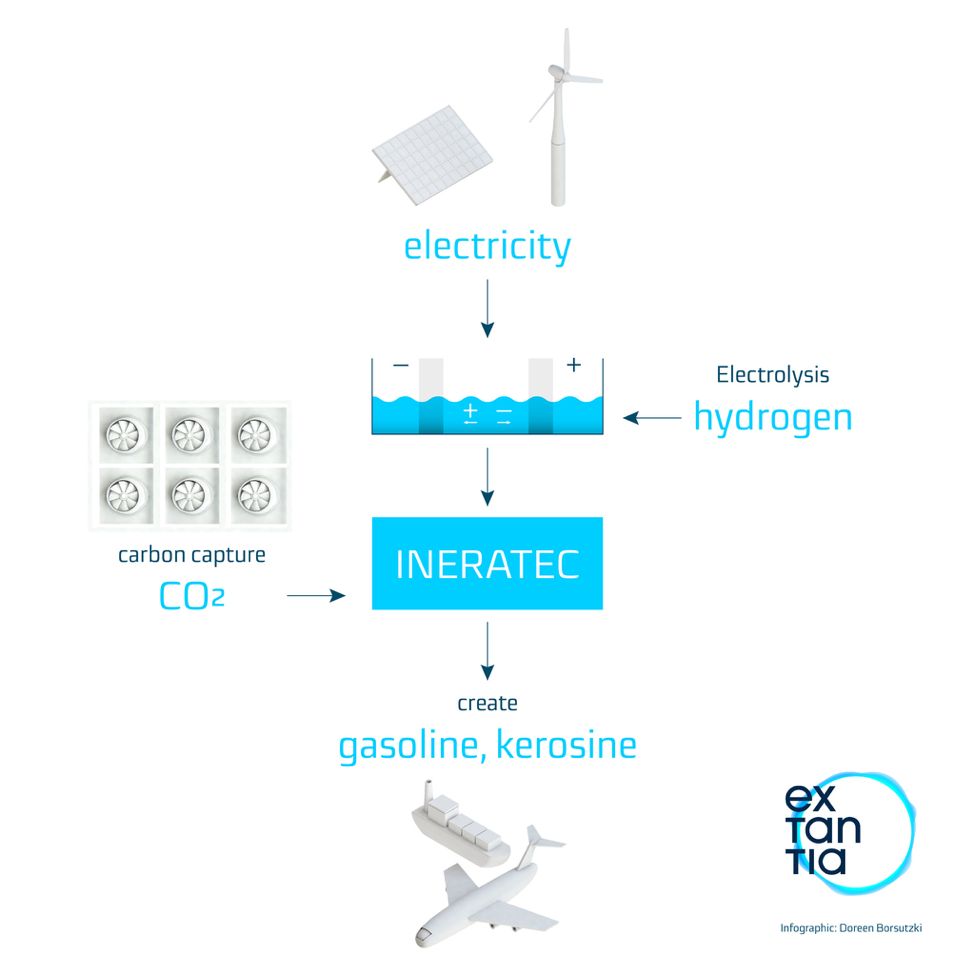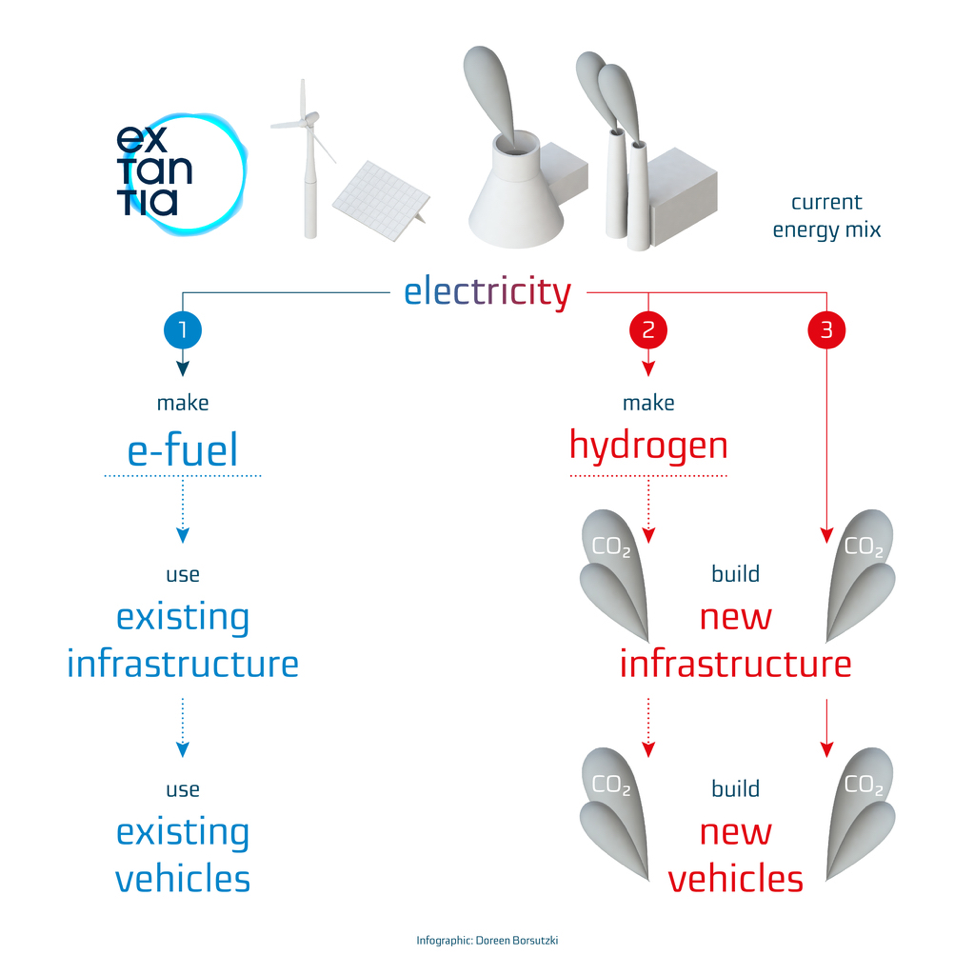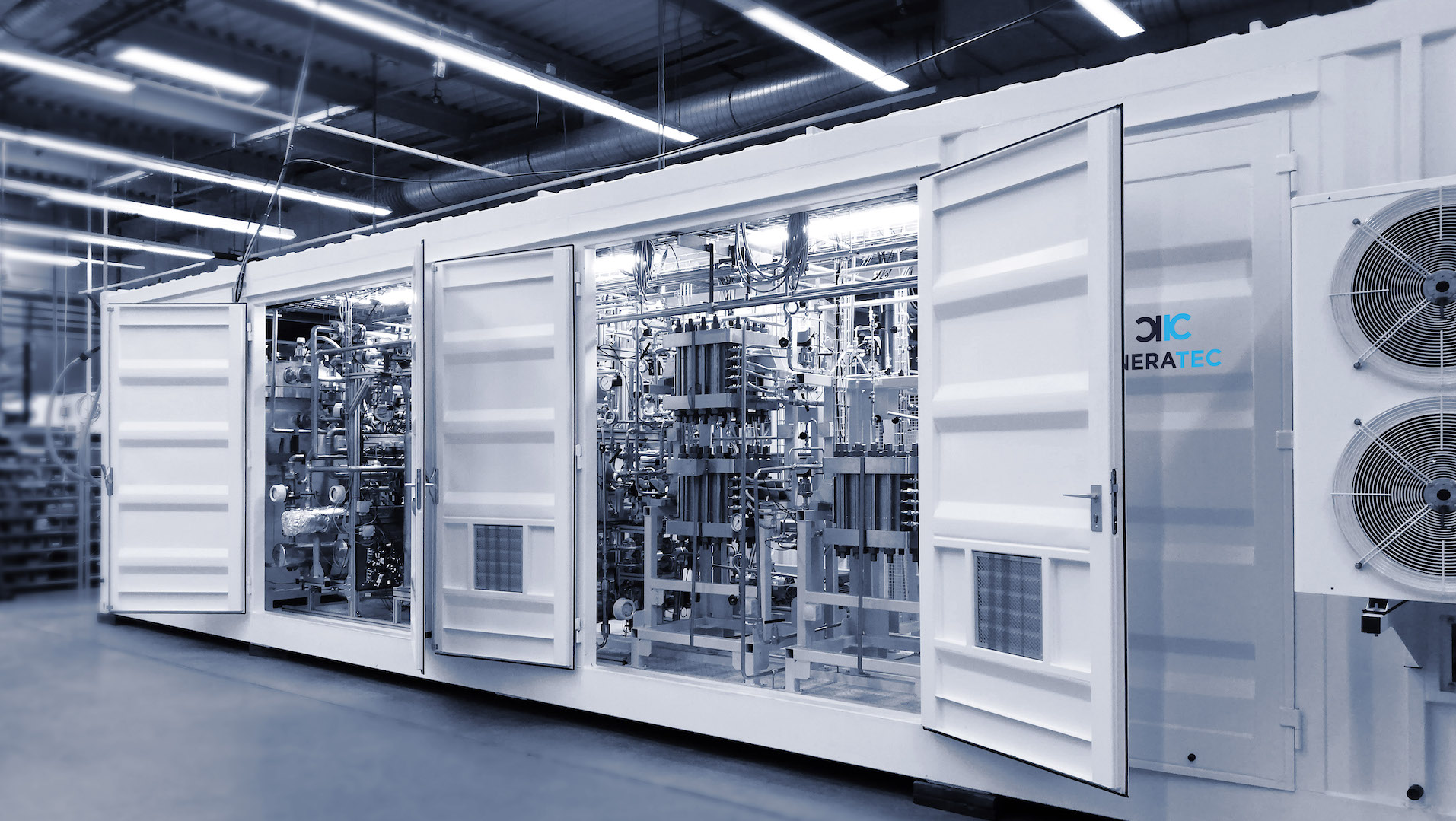In Short:
- The Karlsruhe-based company Ineratec can produce sustainable, liquid fuels at industrial scale by using a Ppower-to-Lliquid (PtL) process based on the Fischer-Tropsch synthesis.
- Its e-fuels are synthetic versions of today’s main liquid fuels, such as kerosene, diesel and gasoline. The main difference is that they were produced with carbon capture from the air – so these fuels produce no net greenhouse gas emissions when burned.
- Ineratec’s fuels are especially useful in hard-to-decarbonize sectors like aviation and shipping, where batteries struggle to provide sufficient energy density (energy per unit of volume or weight). They are also useful for storing energy.
- With policymakers and CEOs around the world making net-zero pledges, Ineratec has a ready-made market for sustainable fuels to power the energy transition.
Most experts agree that the future of transport is direct electrification: in a decarbonized future of net-zero emissions, most vehicles on the road will be powered by electric motors. This is because electric motors are simply more efficient than internal combustion engines, that is, they convert more energy into motion than their competitors.
However, global policymakers are no longer merely talking about cutting emissions here or there, or even just about vehicles on the road or in the driveway. In fact, dozens of countries – including the United States, China, and the member-states of the European Union – have pledged to achieve net-zero emissions, essentially committing to comprehensively reduce emissions throughout every sector. In the transportation sector, they cannot do this without e-fuels.
Another way to use renewable electricity
E-fuels, sometimes called synthetic fuels, are low-emission versions of the petroleum-based hydrocarbons that power most current vehicles, such as gasoline, diesel, or kerosine. (This group also includes substances such e-methanol, synthetic waxes, and synthetic naphtha, which are useful for chemical manufacturers who need hydrocarbons for their molecules, not their potential energy.)
The “e” stands for “electro” because these fuels are produced with renewable electricity. First, manufacturers use wind or solar power to split water molecules and obtain pure hydrogen. Second, they obtain carbon. Crucially, they do so not by extracting oil and gas from the ground but by capturing the carbon, either from power plant exhaust pipes or directly from the surrounding air. Quite literally e-fuels are being made from nothing else but water, air and electricity. This means that when the synthetic fuel is eventually combusted it does not release any additional carbon dioxide into the atmosphere and thus does not further contribute to climate change. Finally, e-fuel manufacturers synthesize these molecules – using for example the Fischer-Tropsch synthesis process or methanation – to create a gas or liquid fuel that emits no net greenhouse gas emissions.
The Karlsruhe-based firm Ineratec is quickly becoming one of the leaders in this space, turning greenhouse gases into carbon-neutral raw materials. Founded in 2014, Ineratec already sells e-fuel production units and e-fuels themselves to dozens of customers across Europe. Philipp Engelkamp, an Ineratec co-founder and managing director, sees major opportunities for growth at a time when firms in Europe and beyond are betting big on low-carbon electricity and sustainable fuels. “The modular expansion of the production capacity is possible due to our unique, innovative reactor technology. It allows us to serially manufacture units and synthetic hydrocarbons from renewable electricity and CO2. We especially see a lot of potential for application in industries like the chemical sector, shipping, and aviation, as well as in heavy duty transportation, which will rely on hydrocarbons for quite some time for technical reasons.”
Our team at Extantia is backing Ineratec because we consider it a “gigacorn” – a company ultimately capable of saving over 1 Gt of CO2 emissions per year that is also commercially viable and operates a scalable business model.

Hard-to-decarbonize sectors and the green e-fuels nexus
Ineratec co-founder Engelkamp emphasizes the promise of using e-fuels in shipping and aviation, what the UN’s Intergovernmental Panel on Climate Change calls “difficult-to-decarbonize” sectors. Why are these sectors hard to decarbonize? Because they require moving heavy cargos over long distances without refueling – every kilogram counts. While lithium-ion batteries can power light-duty passenger vehicles very effectively, they are less suitable for powering heavy trucks, ships, or planes because they have a much lower energy density than petroleum-based liquid fuels.
How to decarbonize these sectors if batteries aren’t a good option? Hydrogen could power fuel cell trucks, but there is no distribution infrastructure in place today. Hydrogen is also too voluminous, and fuel cells too bulky, for the gas to be suitable as a fuel for power-hungry long-haul planes.
E-diesel or e-gasoline, on the other hand, can continue to flow through existing infrastructure such as pipelines and gas stations. These e-fuels can also be burned in internal combustion engines instead of traditional gasoline or blended together with it, which means they can help reduce emissions from the massive fleet of fossil-fueled or hybrid cars already on the road.
Some argue that biofuels, which like e-fuels can be “dropped-in” to existing engines, could be a climate-friendly solution. But claims that biofuels are sustainable miss the mark. Biofuels derive their carbon from plant matter. Therefore, biofuel production generally competes for land with either carbon-sequestering forests or vital farmland. A recent review of academic studies on the life-cycle emissions of biofuels found that any limited greenhouse gas reductions come at the expense of other problems, such as acidification, eutrophication, water overconsumption, and biodiversity loss. EU subsidies for biodiesel have driven deforestation in Indonesia, where farmers cut down trees to produce palm oil.

Cross-sectoral potential
E-fuels’ advantages over batteries, hydrogen, and biofuels explain why Porsche believes e-fuels have “great cross-sectoral potential”. Porsche is just one of the major automakers that is stepping up its efforts in the e-fuels space, and Dr. Sebastian Rudolph, vice president of Communications, Sustainability and Politics at Porsche AG, says the company is “convinced that serial use of e-fuels will be possible within the next 10 years.”
By converting renewable electricity into liquid e-fuels, companies like Ineratec offer a way to store energy over longer periods, to allow Porsche combustion engines to consume energy that humans first captured on a distant solar panel. One of the key features of Ineratec’s chemical reactors is that they are capable of adapting specifically to fluctuating electricity specific to renewable power production which is severely dependent on the weather and time of year.
Engelkamp points out that Ineratec’s e-fuels can carry energy from where it is produced to where it needs to be: “in the medium-term, we see our e-fuel production units at global sweetspots: where renewable electricity is produced at ultra-low costs and high load factors.” When renewable power is cheap and plentiful – think of geothermal power in Iceland or Kenya, wind power in Patagonia, or solar power in North Africa – it is irrelevant that some of the initial energy is lost in the conversion to liquid e-fuels. In these cases, e-fuels are storing energy that might have been lost. Economically, renewable energy produced at a fraction of the cost compared to other locations on earth needs to be compared with process conversion losses in the tens of percentage points.
Ineratec’s e-fuels units are therefore helping to cut emissions indirectly as well as directly. By offering a way to transport renewable electricity to distant markets, they improve the business case for new renewable power installations. And by creating an actual market pull-effect for carbon capture technologies such as Direct Air Capture (DAC), a technology that we at Extantia are putting significant research efforts into, e-fuels play a role in creating a commercial foundation to DAC technologies. In turn – looking beyond the e-fuels pathway – DAC will need to support policymakers to achieve the negative part of “net-zero emissions”, an area where most nations have made little climate progress so far. Ineratec’s products will inevitably be part of an emerging high-tech green nexus.
A readymade market in Europe (and beyond)
On July 14, 2021 the European Commission presented its “Fit-for-55” package, its plan for how the EU will reach its new ambitious emissions targets for 2030. Whereas some firms awaited the policy announcement with trepidation, concerned about their exposure to climate risk, Ineratec waited eagerly to see how its markets would grow.
The early returns were good. The Commission proposed to revise the Energy Taxation Directive to increase minimum tax rates on diesel and kerosine. It also raised EU mandates for the use of sustainable aviation fuels. By 2030, 0.7% of EU aviation fuels should be synthetic fuels of the kind made by Ineratec. In 2050, this requirement will rise to 28%. Both steps should accelerate the aviation industry’s transition to cleaner fuels. As for road transport and maritime shipping, the Commission announced an extension of the EU Emissions Trading Scheme to cover those sectors.
Private actors in the shipping and aviation industries are not resisting this change – far from it. The shipping giant Maersk is aiming for net-zero emissions by 2050 and aims to operate its first carbon-neutral vessel by 2023 – it would run on e-methanol, one of the fuels that Ineratec’s units can produce. Airlines are also taking the initiative: in January, KLM Royal Dutch Airlines operated the powered by synthetic fuel, from Amsterdam to Madrid.
Extantia and Ineratec
Extantia is proud to be supporting Ineratec. Given that aviation and shipping alone account for about 5% of global energy-related CO2 emissions (30 gigatons in 2020), synthetic fuels that Ineratec produces have the potential to save even more than 1 gigaton of CO2. At Extantia, we believe that Ineratec’s combination of innovative synthetic fuel technology and business savvy will make them a success.
For Extantia, the destination of the energy transition is clear: net-zero emissions. The issue now is how to get there. As a producer of the e-fuels that both public and private sector leaders say are necessary to reach the Paris Agreement targets, our partner Ineratec has the wind at its back. Solving the climate crisis will require a whole lot of different approaches in parallel – even within sectors such as transportation. E-fuels are strong at delivering emissions reductions already very soon. We have invested in this round alongside HTGF, Planet A and FO Holding.



